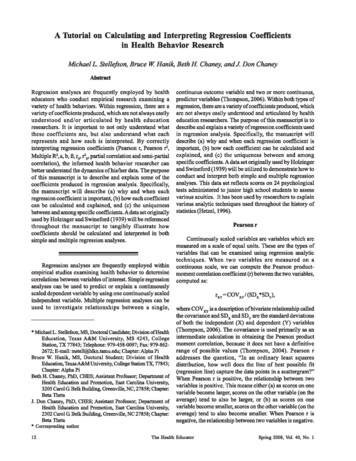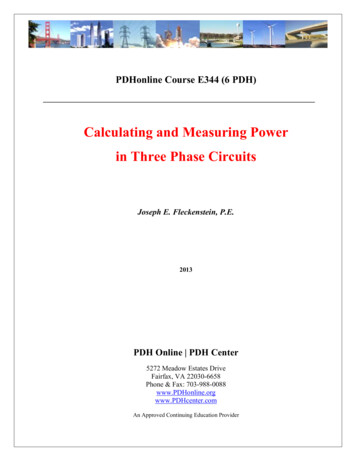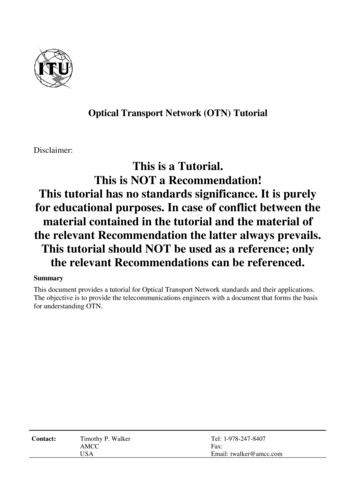
Transcription
A Tutorial on Calculating and Interpreting Regression Coefficientsin Health Behavior ResearchMichael L. Stellefson, Bruce W. Hanik, Beth H. Chaney, and J. Don ChaneyAbstractRegression analyses are frequently employed by healtheducators who conduct empirical research examining avariety of health behaviors. Within regression, there are avariety of coefficients produced, which are not always easilyunderstood andlor articulated by health educationresearchers. It is important to not only understand whatthese coefficients are, but also understand what eachrepresents and how each is interpreted. By correctlyinterpreting regression coefficients (pearson r, Pearson r',Mnltiple R', a, b, B, rs' r's' partial correlation and semi-partialcorrelation), the informed health behavior researcher canbetter understand the dynamics ofhis/her data. The purposeof this manuscript is to describe and explain some of thecoefficients produced in regression analysis. Specifically,the manuscript will describe (a) why and when eachregression coefficient is important, (b) how each coefficientcan be calculated and explained, and (c) the uniquenessbetween and among specific coefficients. Adata set originallyused by Holzinger and Swineford (1939) will be referencedthroughout the manuscript to tangibly illustrate howcoefficients should be calculated and interpreted in bothsimple and multiple regression analyses.Regression analyses are frequently employed withinempirical studies examining health behavior to determinecorrelations between variables of interest. Simple regressionanalyses can be used to predict or explain a continuouslyscaled dependent variable by using one continuously scaledindependent variable. Multiple regression analyses can beused to investigate relationships between a single, Michael L. Stellefson, MS, Doctoral Candidate; Division ofHealthEducation, Texas A&M University, MS 4243, CollegeStation, TX 77843; Telephone: 979-458-0097; Fax: 979-8622672; E-mail: mstell@hlkn.tamu.edu; Chapter: Alpha PiBruce W. Hanik, MS, Doctoral Student; Division of HealthEducation, TexasA&M University, College Station TX, 77843;Chapter: Alpha PiBeth H. Chaney, PhD, CHES; Assistant Professor; Deparbnent ofHealth Education and Promotion, East Carolina University,3205 Carol (l Belk Building, Greenville, NC, 27858; Chapter:Beta ThetaJ. Don Chaney, PhD, CHES; Assistant Professor; Department ofHealth Education and Promotion, East Carolina University,2302 Carol (l Belk Building, Greenville, NC 27858; Chapter:Beta Theta Corresponding author12continuous outcome variable and two or more continuous,predictor variables (Thompson, 2006). Within both types ofregression, there are a variety of coefficients produced, whichare not always easily understood and articulated by healtheducation researchers. The purpose of this manuscript is todescribe and explain a variety ofregression coefficients usedin regression analysis. Specifically, the manuscript willdescribe (a) why and when each regression coefficient isimportant, (b) how each coefficient can be calculated andexplained, and (c) the uniqueness between and amongspecific coefficients. A data set originally used by Holzingerand Swineford (1939) will be utilized to demonstrate how toconduct and interpret both simple and multiple regressionanalyses. This data set reflects scores on 24 psychologicaltests administered to junior high school students to assessvarious acuities. It has been used by researchers to explainvarious analytic techuiques used throughout the history ofstatistics (Hetzel, 1996).PearllonrContinuously scaled variables are variables which aremeasured on a scale of equal units. These are the types ofvariables that can be examined using regression analytictechniques. When two variables are measured on acontinuous scale, we can compute the Pearson pToductmoment correlation coefficient (r) between the two variables,computed as:where COYxy is a description ofbivariate relationship calledthe covariance and SDx and SDy are the standard deviationsof both the independent (X) and dependent (Y) variables(Thompson, 2006). The covariance is used primarily as anintermediate calculation in obtaiuing the Pearson productmoment correlation, because it does not have a defmitiverange of possible values (Thompson, 2004). Pearson raddresses the question, "In an ordinary least squaresdistribution, how well does the line of best possible fit(regression line) capture the data points in a scattergram?"When Pearson r is positive, the relationship between twovariables is positive. This means either (a) as scores on onevariable become larger, scores on the other variable (on theaverage) tend to also be larger, or (b) as scores on onevariable become smaller, scores on the other variable (on theaverage) tend to also become smaller. When Pearson r isnegative, the relationship between two variables is negative .The Health EducatorSpring 2008, Vol. 40, No. 1
This means either (a) as scores on one variable become larger,scores on the other variable (on the average) tend to becomesmaller, or (b) as scores on one variable become smaller,scores on other variable (on the average) tend to becomelarger. The Pearson r is a descriptive statistic, quantifyingthe amount of linear relationship between two continuousvariables. Pearson r statistics themselves, however, areordinally scaled as regards to the variance common to twovariables (Thompson, 2006); therefore, you cannot quantifythe relationship between two distinct Pearson r values unlesseach is squared.Pearson r' (also known as the coefficient ofdetermination or the common variance proportion), unlikePearson r, reflects the percentage of variance common totwo variables (Thompson, 2006). This statistic is notordinally scaled; rather, it is continuously scaled and thus acomparable statistic. It tells us that with knowledge of thescores on one predictive or explanatory, independentvariable, we can explain or predict a given percentage, onthe average, of the variability or Sum of Squares (SOS) of adependent variable. One minus the Pearson r' yields thecoefficient of alienation which describes the proportion ofvariance in the dependent variable that we cannot predictwith knowledge of an independent variable (Thompson,2006).The SOSIlXPLAlNED' or the proportion of the SOS of thedependent variable that is linearly explained by theindependent variable, divided by the SOSTOTAL' the totalamount of explained and unexplained (i.e. not explained bythe independent variable) variability in the dependentvariable (y), tells us the proportion of the variability ofindividual differences that we can explain with an independentvariable (X):r'YX SOSEXPLAINED I SOSlOTALIn the case of two or more independent variables, the Pearsonr' computation above becomes referred to as multiple R', toaccount for the multiple independent variables (XI, X2)having the opportunity to explain or predict the variance inthe dependent variable (Y):R' YXI.xz . SOSEXPLAINED I SOSrour.Pearson r' and multiple R' measure the strength of therelationship between the independent variable(s) anddependent variable. Pearson r' (and multiple R') values havealso been explained as indices which quantify the degree towhich predicted scores match up with actoal scores (Huck,2004).Figure I provides three SPSS (SPSS, Inc., 2006) syntaxesand outputs reflecting two simple (Simple #1 and Simple #2)and one multiple regression analysis using scores onvariables t5 (paragraph Comprehension Test), t6 (GeneralInformation Verbal Test), and t9 (Word Meaning Test).Spring 2008, Vol. 40, No.1In the Simple #1 regression analysis, we are calculatingthe Pearson r' correlation between scores on the WordMeaning Test (entered as the independent variable) andGeneral Information Verbal Test scores (entered as thedependent variable). Notice that the correlation between thetwo variables is r' .547. In the Simple #2 regressionanalysis, we are calculating the Pearson r' correlationbetween scores on the Paragraph Comprehension Test scores(entered as the independent variable) and GeneralInformation Verbal Test scores (entered as the dependentvariable). Notice that the correlation between the two variablesis a bit srnaller, as r' .432. In the Multiple regression analysis,we are calculating the multiple R' correlation to see the effectof Word Meaning Test scores (independent variable) andParagraph Comprehension Test scores (indepedendentvariable) on predicting General Information Verbal TestScores (dependent variable). Notice that the multiple R' (.583)entering both predictors simultaneously is slightly largerthan the r' (.547) between Word Meaning Test scores andGeneral Information Verbal Test scores.The Regression EquationRegression analysis employs two types of weights: anadditive constant, a, applied to every individual participant,and a multiplicative constant, b, applied to the entirepredictor variable for each individual participant (Thompson,2006). The weighting system takes the form of a regressionequation that serves as the set of weights generated in agiven analysis:The a weight is the point where the regression line (i. e.line ofbest fit) crosses the y-axis when x equals O. This pointis also called the y-intercept. To compute the a weight, onemust determine an individual's predicted dependent variablescore (Y) [see Note below]and their correspondingindependent variable (X) score. The regression line alwayspivots on the mean of X (M,J and the mean of Y (My);therefore, the M" is itself a Y score corresponding to ,given that this predicted dependent variable score (My) isalways perfectly predicted to correspond with . With thisknowledge, the M" score can be input as the Y score in theregression equation.When working with standardized scores (i. e. scoreswhich have been standardized by removing or dividing bythe standard deviation (SD) units of both the independentand dependent variables, the a weight will always be equalto zero, because the regression line always pivots on theCartesian Coordinate , M,,), which when dealing withNote: The statistical symbol that is to be a Latincapital letter Y with circumflex (character map:U O 176) is represented as Yin this article.The Health Educator\3
Simple #1REGRESSION!MISSING LISTWISE/STATISTICS COEFF OUTS RANOVA/CRITERlA PIN(.05)POUT(.10)INOORIGINIDEPENDENTt5IMETHOD ENTER t9 .Model SummaryModelRR SquareI.739(a).547Predictor: WORD MEANING TESTAdjusted R Square.545Std. Error of the Estimate8351Simple #2REGRESSION!MISSING LISTWISE/STATISTICS COEFF OUTS RANOVA/CRITERlA PIN(.05)POUT(.10)INOORIGINIDEPENDENTt5IMETHOD ENTER t6 .Model SummaryModelRR SquareAdjusted R SquareI.657(a).432.430Predictor: PARAGRAPH COMPREHENSION TESTStd. Error of the Estimate9347MultipleREGRESSION!MISSING LISTWISE/STATISTICS COEFF OUTS RANOVA/CRlTERlA PIN(.05)POUT(.10)INOORIGINIDEPENDENTt5IMETHOD ENTERt6t9 .Mode\SummaryModelRR SquareAdjusted R SquareI.764(a).583.581Predictors: WORD MEANING TEST, PARAGRAPH COMPREHENSIONTESTStd. Error of the Estimate8.017Figure 1. SPSS syntaxes and outputs for simple and multiple regression(s).standardized scores is (0,0). When the independentvariable(s) is useless (i.e. does not predict or explain any ofthe variation in the dependent variable), the a weight willalways equal the My, because, in this instance, the My is the14best we can do in making the best possible prediction(Thompson, 2006).The b weight is the slope (Le. change in rise/change inrun) of the regression line, and is described as the regressionThe Health EducatorSpring 2008, Vol. 40, No. 1
weight. The value of b signifies how many predicted unitschange (either up or down) in the dependent variable therewill be for anyone unit increase in the independent variable.In a best case scenario, where the independent variable(s)perfectly predicts the outcome variable, the b weight perfectlymatches the dispersions of the Y, (individual's actual score)and y. (individual's predicted score). When the predictorvariable(s) is useless (i. e. does not predict or explain any ofthe variation in the outcome variable), the b weight will equaloto "kill" the useless independent variable and remove itsinfluence from the regression equation (Thompson, 2006). Ifthe metrics of the variables of interest have beenstandardized, the regression weight is expressed as beta (B).A positive B (or b) means that the slope of the regressionline is positive, tilting from lower left to upper right, whereasa negative B (or b) indicates that the slope of the regressionin negative, tilting from upper left to lower right (Huck, 2004).Thus, the sign of b or B indicates the kind of correlationbetween the variables.Consider the SPSS outputs and scatterplots containedin Figure 2. These were developed analyzing the Holtzingerand Swineford (1939) data set discussed earlier. Notice thenon-statistically significant results (P .648) at for the Bweight (.042) describing the correlation between the Memoryof Target Numbers test scores and the General InformationVerbal test scores (Modell). Also, notice the flat regressionline ofbest fit, indicating that the relationship between thesetwo variables is neither positive nor negative (i. e., therelationship is non-existent). Conversely, notice thestatistically significant (P .001) Bweight (.739) describingthe positive relationship between the Word Meaning Testscores (utilized earlier) and the General Information Verbaltest scores (Model 2). This relationship is evidenced by theline of best fit tilting from lower left to upper right.The a and b (or B) weights are constants, in that they donot vary from individual score to individual score. Theirfunction in the regression equation is primarily two fold.First, the b or Battempts to make the spreadoutness of the Yscores (predicted dependent variable scores) and Y scores(actual dependent variable scores) the same, which onlyhappens when a predictor variable perfectly predicts adependent variable. Second, the a weight seeks to makeMy which it always accomplishes perfectly. Essentially,the multiplicative weight (b, Jl) begins the process byaffecting the dispersion (SOSyand central tendency (My) ofY, and then the a weight is turned loose to make My My.Interpreting Regression Coefficients with Co"elatedPredictorsWhen independent variables have nonzero Bs whichdo not equal the independent variable's respective Pearsonr correlation with the dependent variable (y), the independentvariables are said to be collinearwith one another. Collinearityrefers to the extent which the independent variables havenonzero correlations with each other (Thompson, 2006). IfSpring 2008, Vol. 40, No.1two or more independent variables are entered in a multipleregression and those variables are correlated with each otherto a high degree and correlated with the dependent variable,then the B weights for the independent variables are arbitrarilyallocated predictive/explanatory credit among the correlatedindependent variables. The independent variables withhigher Bs are arbitrarily allocated credit for both uniquelyand commonly explained area of the dependent variable. Thisallocation of predictive/explanatory credit given to eachindependent variable can happen only one time, since morethan one independent variable can not be given predictive/explanatory credit for the commonly explained area of thedependent variable (Y). Thus, one must determine what isuniquely explained by each independent variable and howpredictive/explanatory credit is allocated among theindependent variables for the area that is commonlyexplained. The formulas for the iis oftwo correlated predictnrsadjudicates the arbitrary allocation of shared credit(Thompson, 2006):B, ryxl -[(rYX2)( rXIX2)] / [1- r'XIX2]B, rYX2-[(rYXI)(rxI ] / [1- r'XIX2]To mentally conceptualize how these formulas allocatecredit between two independent variables operationalizedin a type ill SOS situation, think ofhorses feeding in a trough.Think of the feed in the trough as the SOSy (SOS of thedependent variable) and each horse representing a uniqueindependent variable, thus each possessing a unique SOSx(assuming the horses are of unequal sizes-i.e. unequalSOSs). The rYXI and r YX2 can be thought of as the amount offeed that each horse can eat from the trough. The rX1X2 isequivalent to the amount offeed that both horses commonly(yet individually) ate from the trough. The amount of feedthat each horse ate from the trough may overlap among bothhorses, so it may be hard to distingnish which horse atewhich proportion of the feed (given that the feed does notstay in a fixed position within the trough). However, as thefarm handler, you may be asked to arbitrarily distingnishwhich horse ate which proportion of the feed. If you wereable to view the amount of newly eaten feed present in eachhorse's stomach, then you would be able to see which horseate more individually (describing both r YXI and r YX2 ) andthus give unique credit to each horse. You can not see this,however, so you must arbitrarily give credit to one (and onlyone) horse for eating a commonly eaten proportion of thefeed (represented within ryxlX2),The structure coefficient (r,) of a predictor variable isthe correlation between the independent variable and Y(Thompson & Borrello, 1985). Recall that the collinearity ofmeasured independent variables affects the is of thesevariables; however, collinearity does not effect rscomputations. Thus, rss are incredibly useful for interpretingregression results (Thompson, 2006). Unless a researcher is(a) researching a specific set of independent variables whichThe Health Educator15
ModellMEMORYOFTARGETNUMBERSStd. ErrorB.042.093Betat.026.457Sig.648Dependent Variable: GENERAL INFORMATION VERBAL TESTo"moooLooooW08CXl0000 ogg g0Z 000Ii"o0 ;!;a.00illW20ooZW"ooeo70eoo90RSq100L 110-1I.waE-.4120MEMORY OF TARGET NUMBERSModel2WORD MEANING TESTStd. Error.063B1.193Beta.739t18.984Sig.000Dependent Variable: GENERAL INFORMATION VERBAL TESTo.1W1- oo!:!zi0 ;!; WZW"000RSq ·O.547020WORD MEANING TEST.Figure 2. Sample SPSS outputs looking at beta weights and scatterplots.16The Health EducatorSpring 2008, Vol. 40, No. 1
are not even remotely affected by other independentvariables or (b) researching independent variables whichare perfectly uncorrelated, then rss should always beinterpreted along with Jl weights (Courville & Thompson,2001). Pedhazur (1982) objected to this necessity and notedthat rss are simply correlations of independent variables withdependent variables divided by multiple R. Thisinterpretation is mathematically valid, but neglects the ideathat the focus of regression analysis is to understand themakeup of Y (the proportion of Y that is explained by theindependent variables), not mathematically divide Pearsonproduct moment correlations by multiple R.Calculating and Interpreting Structure Coefficients (rss)Using SPSSTo calculate rss to explore/confrrm the predictive/explanatory value of independent variables, the researchercan ask SPSS, Version 14.0 (2006) to compute and report rssfor each of the independent variables. Before computing rssfor each independent variable, the user must run a regressionanalysis entering all independent variables together. TheSPSS output resulting from this initial step will provideunstandardized weights (a & b) used to calculate Y. Theseweights are plugged into the equation Y a b(X,) b(X,)b(X,), to create the synthetic variable Y for each individualparticipant.The bivariate correlations between the observedvariables and synthetic variable Yare computed to interpretthe structure coefficients for each independent variable. Thestructure coefficients have been circled in Figure 3 to helpthe reader locate the correlations between the independentvariables and synthetic variable Y (i.e. structure coefficients).One way to check whether or not the correlation table hasbeen calculated correctly is to compare the multiple R fromthe regression model summary generated from the multipleregression to that of the bivariate Pearson r between thedependent variable Y and Y. Notice that these numbers arethe same (.764), and are simply two different ways to expressthe variance proportion of the dependent variable that isexplained by the independent variables. In the exampledepicted in Figure 3, the structure coefficients confumforusthat the beta weights are accurately depicting the explanatorycredit given to each independent variable. It is important toremember, however, that when interpreting B weights,common predictive and/or explanatory credit can not be givento individual independent variables more than once. For thisreason, certain N s with sufficiently large rss may be deniedcredit for predicting or explaining Y. Because of this, both Jland rs must be interpreted, as a predictor may have a nearzero Jl, but have the largest rs and just be denied credit dueto the context specific dynamics of Jl (Thompson, 2006). SeeFigure 4 for an explanation of how to interpret the worth ofan independent variable by examining Jls and rss.Spring 2008, Vol. 40, No.1Partial Correlation CoefficientsPartial correlation is the correlation between twovariables with the influence of a third variable removed fromboth. For example, a researcher could investigate therelationship between height and running speed with theinfluence of age removed from the relationship (Hinkle,Wiersma, and Jurs, 2003). The formula for the partialcorrelation coefficient (of A and B) controlling for only onevariable (C) is:A partial correlation coefficient accounts for or explains thethird variable problem. An extra variable may spuriouslyinflate or attenuste a correlation coefficient (Thompson, 2006),because the common variance between two variables maybe radically different after controlling for the influence of athird variable. Squared partial regression coefficients can bedetermined in multiple regression between the dependentand one of the multiple predictor variables (controlling forthe influence of other predictor variables) using a procedureknown as commonality analysis, which is used to decomposeR' into unique and common explanatory and predictivepowers of the predictors in all their possible combinations(Thompson, 2006).The bivariate correlation and partial correlation matricesfor three of the variables discussed earlier (paragraphComprehension Test scores, General Information Verbal Testscores, and Word Meaning Test scores) are presented inFigure 5. Notice that the correlation between ParagraphComprehension Test scores and General Information VerbalTest scores is rather strong (r .657), as is the correlationbetween Word Meaning Test scores and General Informationtest scores (r .739). However, when the influence of each isremoved from one another, the correlation between WordMeaning test scores and General Information Verbal testscores stays relatively strong (r .517); whereas, thecorrelation between Paragraph Comprehension scores andGeneral Information Verbal Test scores drops noticeably (r .285). From these partial correlations, we can see that,although both variables are highly correlated with the GeneralInformation Verbal test scores, the Word Meaning Testscores remain highly correlated when the influence ofParagraph Comprehension scores is removed fromconsideration. The same can not be said for Word Meaningtest scores, as much ofits correlation with General InfimuationVerbal test scores is lost when the influence ofWord MeaningTest scores is removed. From this analysis of the partialcorrelations, we can vest considerable confidence that thecorrelation between the Word Meaning Test scores andGeneral Information Verbal Test scores is far superior to thecorrelation between Paragraph Comprehension scores andGeneral Information Verbal Test scores.A semi-partial correlation or part correlation is thecorrelation between two variables with the influence of aThe Health Educator17
SPSS Syntax for computing structure coefficientsCOMPUTEyhat 21.205 t9·.886 t6· .965 tl5' -.034.EXECUlE.COMPUTE e t5 - yhat.EXECUlE.list variables t9 t6 tl5 t5 yhat e.CORRELATIONSNARIABLES t9t6t15t5 yhateIPRINT TWOTAILNOSIGIMISSING PAIRWISE.SPSSOutputRegression Model SummaryRRSquare764.584Adjusted R SquareStd. Error of the Estimate.5808.027Predictors: MEMORY OF TARGET NUMBERS, WORD MEANING TEST, PARAGRAPH COMPREHENSION TEST;Dependent Variable: GENERAL INFORMATION VERBAL TESTBeta WeightsUnstandardizedCoefficientsBSE21.205 (a).886(Constant)WORD MEANING dent Variable: GENERAL INFORMATION VERBAL TESTStructure SGENINFOVERBALTESTyhatI.704".052.739".967"PC 4: I.764".764"I"Correlation is significant at the 0.01 levelFigure 3. Interpreting beta weights and structure coefficients.18The Health EducatorSpring 2008, Vol. 40, No. 1
If the predictor variable has a .Then .r, equal to 0a equal to 0It is a useless predictor. It explains none of the variation in thedependent variable.r, not equal to 0a equal to 0The predictor variable explains some of the variation in thedependent variable, but other predictor variables are gettingexplanatory credit for what is being explained by the predictorvariable.r, equal to 0a not equal to 0The predictor variable does not directly explain any of thevariation in the dependent variable, but its presence doesincrease the explanatory credit assigned to other predictorvariables.Figure 4. Interpreting the as and rss of a predictor variable.third variable taken away from only one ofthe two variables.For example, you conld investigate the relationship betweenheight and running speed with the influence of age removedfrom only the height variable (Hinkle, Wiersma, and Jurs,2003). The formula for the semi-partial or part correlationcoefficient ofY and Z, removing the effects ofX from only Yis:rZ(Y.X) (ryz - r"",xz / square root of I -This equation actually reflects the correlation between Zand the error ofY (Hinkle, Wiersma, and Jurs, 2003). Thesample size necessary for adequate semi-partial correlationestimation accuracy depends strongly on three factors: (a)the population squared multiple correlation coefficient, (b)the population increase in coefficient, and (c) the desireddegree of accuracy. The number of predictors has a smalleffect on the required sample size (AJgina, Moulder, & Moser,r xy)'2002).CorrelationsGENERALINFOVERBALTESTGEN INFO VERBAL TESTPearson CorrelationPARA COMP TESTPearson CorrelationWORD MEANING TESTPearson CorrelationPARAGRAPHCOMPTESTIWORD MEANINGTEST.657.739.6571.704.739.7041Partial CorrelationsControl VariableWORD MEANING TEST PARACOMPTESTGEN INFO VERBAL TESTPartial CorrelationPartial CorrelationControl VariablePARA COMP TESTPARAGRAPHCOMPTESTGENERALINFOVERBAL TEST1.285.2851GENERALINFO WORD MEANINGTESTVERBAL TESTGENINFO VERBAL TESTWORD MEANING TESTPartial CorrelationPartial Correlation1.517.5171Figure 5. Correlation/partial correlation matrices.Spring 2008, Vol. 40, No.1The Health Educator19
Implications for Helllth Education ResearchReferencesAs noted by Bubi (2005), there is a paucity of articlesrelated to statistics or measurement in health education.Unlike other fields within the social sciences, health educationhas been conspicuously absent from the dialoguesurrounding the implementation and interpretation of variousstatistical analyses. While analyses such as regression arefrequently employed by health education researchers,scholars in health education should be able to understandand explain the variety of regression coefficients which canbe analyzed. The lack of scholarly discussion in the field(regarding the interpretation of statistical coefficients)discourages empirical knowledge generation and encouragessimply memorizing procedures to produce numerical indices.The health education profession must strive to generate,report, and interpret various regression coefficientsaccurately and adroitly, so that data explication appropriatelyreflects the reality we wish to purport. There has beendiscussion regarding the interpretation of effect sizes inhealth education research (Bubi, 2005; Merrill, Stoddard, andShields, 2004; Watkins, Rivers, Rowell, Green, & Rivers,2006), and it is suggested that similar recommendations stressthe importance of computing structure coefficients tocomplement traditional beta weight coefficients. Throughthis practice, health educators will be able to more accuratelydistioguish independent variables which are responsible forimpacting our dependent health behaviors of interest. Forhealth education to improve its position as a science, it mustembrace the practice of these analytic interpretations.Mandating the need to accurately report and interpretregression coefficients in all realms of health educationresearch is essential to advancing result efficacy in the field.Algina, J., Moulder, B. C., Moser, B. K. (2003). Sample sizerequirements for accurate estimation of squared semipartial correlation coefficients. Multivariate BehavioralResearch, 37(1), 37-57.Bubi, E. R (2005). The insignificance of "significance" tests:Three recommendations for health educationresearchers. American Journal of Health Education,36,109-112.Courville, T., & Thompson, B. (2001). Use of strocturecoefficients in published multiple regression articles: Iiis not enough. Educational and PsychologicalMeasurement, 61, 229-248.Hetzel, R D. (1996).Aprimer on fuctor analysis with commentson pattems of practice and reporting. In B. Thompson(Ed.), Advances in social science methodology (Vol. 4).Greenwich, CT: JAI Press.Hinkle,D.E., Wiersma, w.,Jurs, S. G (2003).Appliedstatisticsfor the behavioral sciences. Boston: Houghton MifflinCompany.Holzinger, K. J., & Swineford, F. (1939). A study infactor
Figure I provides three SPSS (SPSS, Inc., 2006) syntaxes and outputs reflecting two simple (Simple #1 and Simple #2) and one multiple regression analysis using scores on variables t5 (paragraph Comprehension Test), t6 (General Information Verbal Test), and t9 (Word Meaning Test). In the Simple #1 regression analysis, we are calculating










